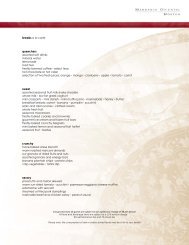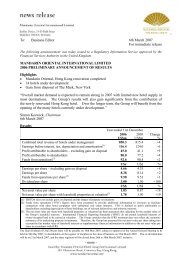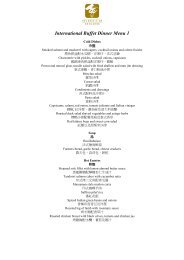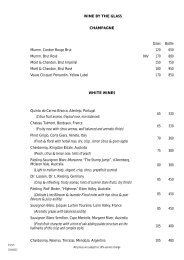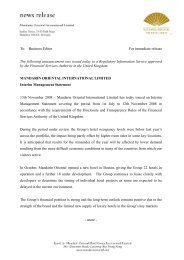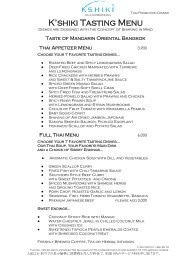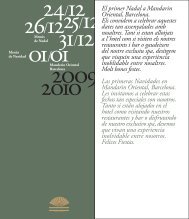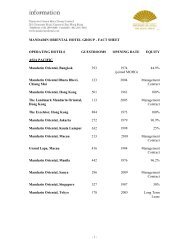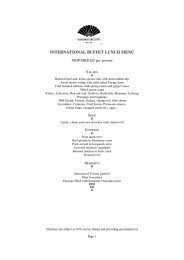Annual Report 2011 - Mandarin Oriental Hotel Group
Annual Report 2011 - Mandarin Oriental Hotel Group
Annual Report 2011 - Mandarin Oriental Hotel Group
You also want an ePaper? Increase the reach of your titles
YUMPU automatically turns print PDFs into web optimized ePapers that Google loves.
44 <strong>Mandarin</strong> <strong>Oriental</strong> International Limited<br />
Financial Risk Management Continued<br />
A Financial risk factors continued<br />
iii) Liquidity risk<br />
Prudent liquidity risk management includes managing the profile of debt maturities and funding sources,<br />
maintaining sufficient cash and marketable securities, and ensuring the availability of funding from an adequate<br />
amount of committed credit facilities and the ability to close out market positions. The <strong>Group</strong>’s ability to fund its<br />
existing and prospective debt requirements is managed by maintaining diversified funding sources with adequate<br />
committed funding lines from high quality lenders, and by monitoring rolling short-term forecasts of the <strong>Group</strong>’s<br />
cash and gross debt on the basis of expected cash flows. In addition, long-term cash flows are projected to assist<br />
with the <strong>Group</strong>’s long-term debt financing plans.<br />
At 31st December <strong>2011</strong>, total available borrowing facilities amounted to US$678 million (2010: US$715 million)<br />
of which US$582 million (2010: US$577 million) was drawn down. Undrawn committed facilities, in the form<br />
of revolving credit and term loan facilities, totalled US$96 million (2010: US$138 million).<br />
The table below analyzes the <strong>Group</strong>’s non-derivative financial liabilities and net-settled derivative financial<br />
liabilities into relevant maturity groupings based on the remaining period at the balance sheet date to the<br />
contractual maturity date. Derivative financial liabilities are included in the analysis if their contractual<br />
maturities are essential for an understanding of the timing of the cash flows. The amounts disclosed in the<br />
table are the contractual undiscounted cash flows.<br />
Within Between Between Between Between Beyond Total<br />
one one and two and three and four and five undiscounted<br />
year two years three years four years five years years cash flows<br />
US$m US$m US$m US$m US$m US$m US$m<br />
At 31st December <strong>2011</strong><br />
Borrowings 17.7 22.7 538.3 34.6 2.1 5.4 620.8<br />
Creditors 122.7 – – – – – 122.7<br />
Net settled derivative<br />
financial instruments 6.6 6.9 3.6 0.7 0.4 0.1 18.3<br />
At 31st December 2010<br />
Borrowings 16.6 17.7 23.8 532.9 29.5 7.5 628.0<br />
Creditors 96.7 – – – – – 96.7<br />
Net settled derivative<br />
financial instruments 7.2 6.5 3.9 1.6 – – 19.2<br />
B Capital management<br />
The <strong>Group</strong>’s objectives when managing capital are to safeguard the <strong>Group</strong>’s ability to continue as a going concern<br />
whilst seeking to maximize benefits to shareholders and other stakeholders. Capital is equity as shown in the<br />
consolidated balance sheet plus net debt.<br />
The <strong>Group</strong> actively and regularly reviews and manages its capital structure to ensure optimal capital structure and<br />
shareholder returns, taking into consideration the future capital requirements of the <strong>Group</strong> and capital efficiency,<br />
prevailing and projected profitability, projected operating cash flows, projected capital expenditures and projected<br />
strategic investment opportunities. In order to maintain or adjust the capital structure, the <strong>Group</strong> may adjust the<br />
amount of dividends paid to shareholders, purchase <strong>Group</strong> shares, return capital to shareholders, issue new shares<br />
or sell assets to reduce debt.



